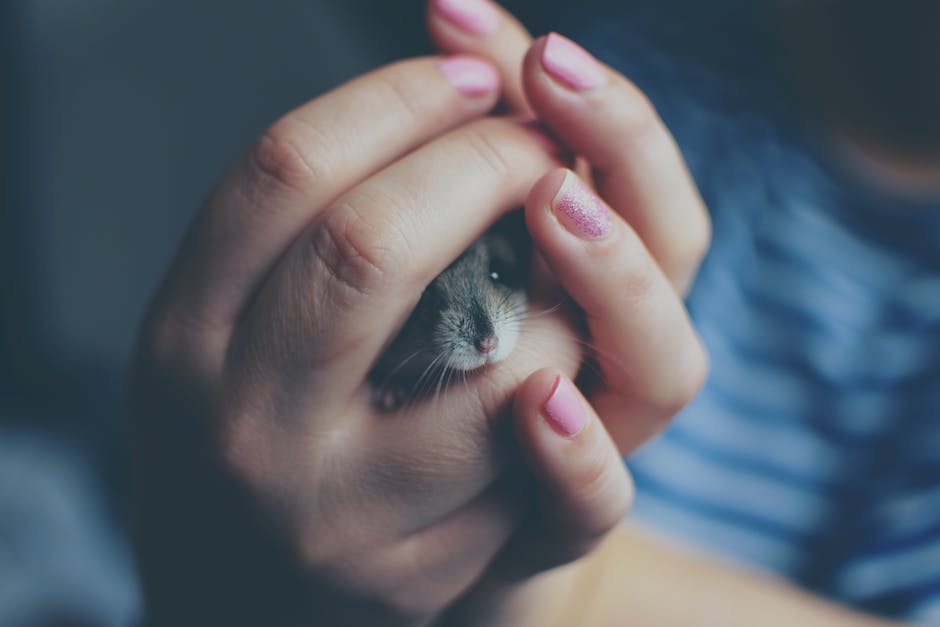There are a few things to keep in mind when caring for a hamster. Here are some dos and don’ts to help you give your furry friend the best life possible.
DO: Give your hamster a spacious cage to live in. They need room to run and explore.
DON’T: Overcrowd the cage with too many toys or extras. This can be overwhelming for a hamster.
DO: Keep the cage clean. This means regular spot-cleaning as well as a full cleaning every few weeks.
DON’T: Use cleaning products that are harsh or toxic. These can be dangerous for your hamster.
DO: Provide your hamster with fresh water and food daily.
DON’T: Feed your hamster spoiled food or Table scraps.
DO: Handle your hamster gently and let them get used to you before picking them up.
DON’T: Suddenly grab your hamster or hold them too tightly. This can scare them and cause them to bite.
By following these simple dos and don’ts, you can make sure your hamster has a happy and healthy life.
There are a few things to keep in mind when caring for a hamster. First, don’t overfeed them. They tend to overeat and then get sick. Second, don’t underfeed them. They need a balanced diet to stay healthy. Third, don’t neglect their housing. They need a clean, comfortable place to live. Lastly, don’t mishandle them. They are delicate creatures and can easily be injured.
What should you not do to your hamster?
There are a few things you should avoid doing when you have a hamster:
1. Don’t place the cage in the kitchen or near an open window. The noise and activity can be too much for them.
2. Don’t adopt two of them unless you are prepared to care for them properly. They need their own space and will fight if they feel crowded.
3. Don’t feed them only sunflower seeds. They need a balanced diet and sunflower seeds are not enough.
4. Don’t wash your hamster. They are very clean animals and don’t need to be bathed.
5. Don’t awaken them suddenly. They are very sensitive to noise and movement and it can startle them.
A pet hamster can make a great addition to your family. Here are 9 care tips for beginners to help you get started:
1. Choose a habitat: A good habitat for your hamster should be at least 24” x 12” x 12”.
2. Put their habitat in the right place: Your hamster’s habitat should be in a quiet place away from drafts.
3. Cover their habitat with a light cloth for the first few days: This will help your hamster feel more secure in their new home.
4. Wait a few days before trying to pick them up: Once your hamster is acclimated to their new habitat, you can start to pick them up. Be gentle!
5. Once they’re acclimated, think outside the box for feeding time: Your hamster will appreciate a variety of foods, so get creative with their meals.
6. Clean and wash your hamster’s space regularly: A clean habitat is a happy habitat!
7. Get your hamster a friend: Hamsters are social creatures and do best with a friend.
8. Handle your hamster often: Get to know your hamster by
Are hamsters easy to care for
Many people believe that hamsters make excellent pets. They are low maintenance, get plenty of exercise from running on their wheel, and are typically very cute and cuddly. They can be a great starter pet for children.
It’s important to interact with your hamster(s) every day, and handle them as often as you can, but respect their sleeping pattern. Hamsters should not be handled when they are resting or sleeping, unless absolutely necessary as they can find this stressful.
What is toxic to hamsters?
Chocolate is poisonous to hamsters, so be sure to keep it away from them. Garlic can also cause indigestion and blood disorders, so it’s best to avoid giving it to your hamster. Kidney beans are also toxic to hamsters, so make sure not to feed them to your pet.
Hamsters are solitary animals and prefer to live alone. It is their instinct to defend their territory and they don’t get lonely or depressed about being on their own.
Do hamster bites hurt?
It’s very rare for a hamster to be aggressive, but they may sometimes bite when they feel scared. Although their teeth aren’t as sharp as other animals, it can still be quite painful. You can gradually train your hamster to be more comfortable with handling, which will reduce the likelihood of biting.
Although most hamsters don’t require additional bathing with soap and water, your hamster might require occasional help with cleaning their rear end to prevent caked fecal material or urine staining. If your vet instructs you to give your hamster a bath, make sure to use a gentle, unscented soap and warm water.
What is the fastest way to tame a hamster
If you want to tame your hamster, it is important to get them used to your voice and your hand. You can place a treat in your open palm and allow them to come to you. Once they are comfortable with being in your hand, you can begin to hold them and interact with them. Getting them used to being outside of their cage is also important, as this will allow you to have more fun with them.
For small animals like hamsters, it is best to provide them with a species-appropriate fitness ball. This will keep them safely contained while still allowing them the freedom to run around and explore their environment.
Do hamsters need a bed?
Bedding is important for hamsters because it provides them with a safe and comfortable environment to nest and burrow. Good bedding leads to happy and healthy hamsters!
While hamsters are generally low-maintenance pets, there are a few things to keep in mind to ensure your furry friend is happy and healthy.
Males and females should not be housed together, as they will fight. Syrians shouldn’t be housed together at all, as they are known to be territorial and can become aggressive.
Hamsters need a lot of exercise, so a large cage with plenty of space to run is a must. They’re nocturnal creatures, so don’t be alarmed if they’re up and about while you’re trying to sleep!
They dislike loud noises, so try to keep things calm and quiet around them. Pet shop owners often make the mistake of assuming all hamsters are the same, when in fact there are several different kinds.
Timid by nature, hamsters can take a little time to warm up to their owners. But once they do, they’re great fun to play with.
Hamsters are omnivores, so their diet should consist of a balance of proteins, fruits, and vegetables.
Do hamsters like being in a ball
The hamster ball is an exercise device for hamsters that is designed to allow the hamster to exercise while enclosed in the ball. However, there are concerns that such products may actually be stressful for hamsters and so the RSPCA does not recommend their use.
Hi!
It’s generally a good idea to limit free roam time for your hamster, especially if they’re not used to it. I would recommend around 15-30 minutes for the first few times. They may get disoriented in a bigger environment and prolonged free-roam may stress them out.
Hope this helps!
How long should I not touch my hamster?
new
It is best to avoid handling your new hamster for the first 12 to 24 hours after you bring it home. This will give the hamster time to get used to its new environment and feel comfortable with its new surroundings. Larger Syrian hamsters are more tolerant of being held than dwarf hamsters, but all hamsters will live longer, happier lives if you create a nurturing environment for them.
Hamsters are not domesticated animals and are closer to wild animals. This means that keeping them in any closed environment is incredibly stressful to them.
What do hamsters like to play with
Hamsters love to chew on things, so it’s always a good idea to provide a non-toxic chew toy Wood toys are a good option, as long as the wood is pesticide/chemical free (not pressure-treated or painted) Avoid wood from cedar or evergreen trees due to their aromatic oils, which can cause respiratory irritation
Fresh fruits and vegetables are good for hamsters, as long as they are washed in water first. Avoid giving citrus fruits, as they can be harmful. Whole grain breads and cereals are also good for hamsters.
Should I get 1 or 2 hamsters
It’s important to only have one hamster per cage to avoid fighting and potential death. Hamsters are loners and do not do well in pairs or groups, so it’s best to just stick to one per cage. Thanks for being responsible!
Most hamsters and degus love a sand bath and it helps keep their coats shiny and healthy. It’s best not to keep the sand bath in their cage all the time, as overuse can cause drying out of their skin.
Do hamsters sleep at night too
Hamsters are supposed to sleep for most of the day and be awake for most of the night. It is normal for a hamster to move around during the early morning or late evening as well as periodically move and shift throughout the day. This helps the hamster to stay active and avoid predators.
LCMV is a virus that can infect pet rodents, such as hamsters and guinea pigs. It is possible for humans to become infected with LCMV if they come into contact with infected rodents at a breeding facility, pet store, or home. Although human infections from pet rodents are rare, they can occur. If you have a pet rodent, it is important to monitor it for signs of illness and to practice good hygiene to prevent the spread of infection.
How to tame hamster
Processing refers to the act of taking something in and making sense of it. So, in the context of giving your hamster a treat, processing would involve taking the treat and understanding that it is something that is meant for them. If they take the treat, then they have processed that information and are likely to enjoy it. If they don’t take the treat, then they may not have processed the information correctly, or they may not be interested in the treat.
Hamsters bite because they’re scared or feel threatened. It’s actually a natural reaction, and stems from them being prey animals; they need a way to protect themselves. 8 9 2020
Can hamsters eat grapes
Yes, hamsters can eat grapes. However, it is best to feed them in moderation or just as an occasional treat because grapes are high in sugar.
Dwarf hamsters are very intelligent creatures that love to play and explore once they’ve gotten used to you and their new home. They are also smart enough to recognize and respond to their own name once you’ve trained them to do so.
Do hamsters need toilet paper
Toilet paper may seem like an unlikely choice for material to build a nest with, but there’s a good reason hamsters like to use it. It’s soft and light, which makes it comfortable for them to sleep on. However, toilet paper can get damp and cause your hamster’s cage to smell bad quickly, so you may want to consider using a different type of material for their nest.
If you want to get your hamster used to being handled, start by keeping the sessions short and sweet. Aim for just 10-15 minutes at a time, and make sure the handling is gentle. This will show your hamster that handling doesn’t have to be a long or scary process, and he’ll be back in his enclosure in no time. This will help build his confidence and make him more comfortable with being handled.
Warp Up
There are a few key things to remember when caring for a hamster:
DO
-Provide a safe and clean environment
-Give your hamster ample food and water
-Handle your hamster gently and carefully
-Provide your hamster with chew toys and plenty of space to play
DON’T
-Leave your hamster’s cage in direct sunlight
-Give your hamster sugary snacks or food
– neglect to clean your hamster’s cage
– over handle your hamster, which can cause stress
If you are considering getting a hamster as a pet, there are a few things you should keep in mind in terms of care. First, do your research so that you are aware of the basic needs of a hamster. Then, create a comfortable home for your hamster complete with a cage, bedding, food and water bowls, and toys. Once you have everything in place, you can bring your new hamster home! Lastly, remember to handle your hamster gently and provide regular opportunities for exercise. By following these simple dos and don’ts, you can make sure that your hamster is happy and healthy.







